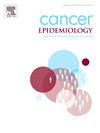健康饮食指数(HEI-2020)评分与结直肠癌风险
IF 2.4
3区 医学
Q3 ONCOLOGY
引用次数: 0
摘要
目的:本研究的目的是评估意大利人群中与健康饮食指数2020 (HEI-2020)衡量的2020 - 2025年美国人饮食指南(DGA)的一致性是否与结直肠癌(CRC)风险相关。方法1992 ~ 1996年在意大利开展多中心病例对照研究。1953例患者(男性58 %,中位年龄62岁)因组织学证实的结直肠癌住院。对照组为4154例患者(男性50 %,中位年龄58岁),因急性非肿瘤性疾病入住同一家医院。使用经过验证的食物频率问卷收集研究入组前参与者的日常饮食,并使用HEI-2020评分评估与DGA的一致性,范围在0(不一致)到100(完全一致)之间。比值比(ORs)和相应的95% %置信区间(ci)使用多重逻辑回归模型进行估计,包括选定的社会经济、生活方式因素和潜在混杂因素。结果HEI-2020得分在29.4 ~ 97.0之间。得分最高分位数的受试者患结直肠癌的风险低于得分最低分位数的受试者(OR: 0.69, 95 % CI = 0.60-0.80)。在结肠癌(OR: 0.70, 95 % CI = 0.59 - 0.83)和直肠癌(OR: 0.69, 95 % CI = 0.56-0.85)中也发现了类似的估计。这些发现在不同协变量的各个层次上也是一致的。结论:在意大利人群中,DGA与结直肠癌风险呈负相关。本文章由计算机程序翻译,如有差异,请以英文原文为准。
Healthy Eating Index (HEI-2020) score and colorectal cancer risk
Purpose
The aim of this study is to evaluate if the alignment with the 2020–2025 Dietary Guidelines for Americans (DGA), measured by the Healthy Eating Index 2020 (HEI-2020), is associated with colorectal cancer (CRC) risk in an Italian population.
Methods
A multicentric case-control study was carried out in Italy between 1992 and 1996. Cases were 1953 patients (males 58 %, median age = 62 years) admitted to major hospitals with incident, histologically confirmed CRC. Controls were 4154 patients (males 50 %, median age = 58 years) admitted to the same hospitals for acute non-neoplastic conditions. Participants’ usual diet before study enrolment was collected using a validated food frequency questionnaire, and the alignment with DGA was assessed using the HEI-2020 score, ranging between 0 (no alignment) and 100 (complete alignment). Odds ratios (ORs) and the corresponding 95 % confidence intervals (CIs) were estimated using multiple logistic regression models including terms for selected socioeconomic, lifestyle factors, and potential confounders.
Results
The HEI-2020 score ranged from 29.4 and 97.0. Subjects in the highest tertile of scores had lower risk of CRC compared to those in the lowest tertile (OR: 0.69, 95 % CI = 0.60–0.80). Similar estimates were found for colon (OR: 0.70, 95 % CI = 0.59 – 0.83) and rectal cancer (OR: 0.69, 95 % CI = 0.56–0.85). The findings were also consistent across strata of different covariates.
Conclusions
Alignment with DGA was inversely associated with CRC risk in an Italian population.
求助全文
通过发布文献求助,成功后即可免费获取论文全文。
去求助
来源期刊

Cancer Epidemiology
医学-肿瘤学
CiteScore
4.50
自引率
3.80%
发文量
200
审稿时长
39 days
期刊介绍:
Cancer Epidemiology is dedicated to increasing understanding about cancer causes, prevention and control. The scope of the journal embraces all aspects of cancer epidemiology including:
• Descriptive epidemiology
• Studies of risk factors for disease initiation, development and prognosis
• Screening and early detection
• Prevention and control
• Methodological issues
The journal publishes original research articles (full length and short reports), systematic reviews and meta-analyses, editorials, commentaries and letters to the editor commenting on previously published research.
 求助内容:
求助内容: 应助结果提醒方式:
应助结果提醒方式:


